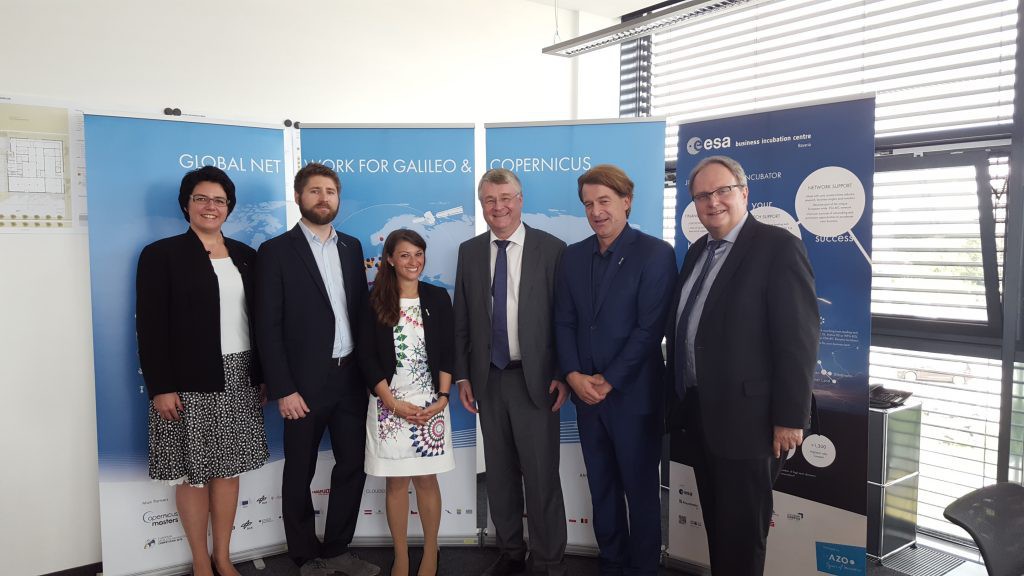During his visit to Bavaria, including meetings with State Minister Merk and Landtag President Stamm, Markku Markkula, President of the EU Committee of the Regions visited AZO. Markku Markkula took a tour of AZO’s business headquarters in Oberpfaffenhofen to get to know AZO and its forward-thinking initiatives, supporting growth all along the value chain.
Bavaria – Europe’s Innovation Hub for Galileo and Copernicus
Bavaria is the birthplace of the largest innovation networks for Galileo and Copernicus. AZO established a huge infrastructure for Europe’s largest space programmes, resulting in global innovation networks over the past 13 years. Both the Copernicus Masters and the European Satellite Navigation Competition (ESNC) serve as catalysts for new jobs and growth in Bavaria and Europe within the downstream space sector. The competitions’ success is mainly driven by their regional dimension and dedicated partners. This development is essential to ensure a Europe-wide support infrastructure and foster economic development in all regions of Europe. The well-established networks consist of more than 140 stakeholders.

The Largest European Innovation Network for Galileo
The ESNC’s annual search for new services, products, and business innovations is designed to encourage the use of satellite navigation in everyday life. Over the past decade, it has evolved into the leading innovation competition comprising partner regions worldwide, the largest space-related incubation network and the most relevant European GNSS stakeholders: the European GNSS Agency (GSA), the European Space Agency (ESA), the German Aerospace Center (DLR), the German Federal Ministry of Transport and Digital Infrastructure (BMVI), and the Horizon 2020 project BELS. In addition, more than 20 partner regions from the entire world will host regional challenges. The ESNC 2016 prize pool contains a value of approximately EUR 1 million. Prizes include: cash awards, business incubation, business coaching, patent consulting, technical support, access to testing facilities, prototype development, publicity and marketing support. Submission is possible each year from 1 April – 30 June at http://www.esnc.eu/.
The Leading Innovation Platform for Copernicus Space Applications
Geared towards entrants from all over the world, the sixth edition of the biggest international competition in the commercial use of Earth observation data is on the hunt for outstanding ideas, applications, and business concepts that use such information in everyday life. Renowned partners, including the European Space Agency (ESA), the German Aerospace Center (DLR), T-Systems International GmbH, Satellite Applications Catapult Ltd., the German Federal Ministry of Transport and Digital Infrastructure (BMVI), and Stevenson Astrosat Ltd, are sponsoring prizes in seven topic-specific challenges. Along with cash prizes, the winners will receive access to a leading international network, corresponding data, startup funding, and other support valued at more than EUR 600,000 in total. Furthermore, the Top 40 of the competition will enter the unique Copernicus Accelerator programme to boost their ideas to the next level. The submission phase is scheduled to end on 25 July 2016 at http://www.copernicus-masters.com/.
Bavaria as Successful Aerospace Location in Europe
By leveraging its extensive experience as a specialist in building and maintaining global innovation networks and organising related competitions, Anwendungszentrum GmbH Oberpfaffenhofen (AZO) supports product innovations and the creation of new companies, particularly in the field of commercial aerospace applications.
Markku Markkula got first-hand insights how the AZO initiatives make Bavaria such a successful aerospace location in Europe.
Just to name a few figures: Out of more than 400 developed ideas in ESA BICs all over Europe, AZO enabled the creation of more than 105 companies and 1,300 jobs, an annual turnover of over EUR 100 Million and a success rate of 89 percent. ESA incorporates 13 Business Incubation Centres (BICs) throughout Europe. The most successful incubator is the ESA BIC Bavaria located in Oberpfaffenhofen at AZO’s headquarters.
Providing Europe with Pioneering Entrepreneurs from Bavaria
The ESA BIC Bavaria seeks entrepreneurs using space technologies in a non-space environment. That does not mean rocket science, but applies to multiple application fields such as navigation and positioning, communications techniques, Earth observation, materials, processes, signals or robotics. ESA’s Business Incubation Centre Bavaria was launched in 2009 and is ever since managed by Anwendungszentrum GmbH Oberpfaffenhofen (AZO) on behalf of the European Space Agency (ESA). ESA BIC Bavaria and its renowned partners – DLR, Airbus Defence and Space, Fraunhofer IIS and Wirtschaftsförderungsgesellschaft Berchtesgadener Land – provide startups with financial and technical support at four branch offices: Oberpfaffenhofen, Ottobrunn, Nürnberg and Berchtesgadener Land.
The EU Committee of the Regions’ delegation visited two successful ESA BIC Bavaria companies: Lilium and ViaLight.

Lilium GmbH is developing, building, and selling a two-seated electric jet capable of vertical take-off and landing (VTOL). The company was founded in February 2015 by four engineers and PhD students from Technical University of Munich. Lilium has developed an entirely new aircraft concept for vertical take-off (patent pending) that opens the door to a new class of simpler, safer, quieter, and more enduring VTOL aircraft. It has validated the concept with several scaled prototypes weighing 25 kg, and is now developing its first product: a two-seated ultralight VTOL jet. Lilium has a highly diversified team of experts in fields ranging from aerodynamics, flight control, and CFRP structures to electric propulsion and product design. Together, its members are developing aircraft designed for use in everyday life.
ViaLight Communications is a spin-off of the German Aerospace Center (DLR) and was founded 2009. The company offers laser communication solutions for data transmission between flight platforms, such as unmanned aerial vehicles (UAVs), aircraft and high altitude platforms (HAPs), and from flight platforms to the ground. This technology is especially interesting for flight-platform manufacturers and operators, who experience a bottleneck in real-time communication from their platforms. The spin-off was supported by the DLR Institute for Communication and Navigation, by the DLR Technology Marketing division, the DLR office in Washington, USA, as well as by ESA BIC Bavaria programme in which the DLR is involved as a technical partner.
Stay tuned for the latest trends and read current news on the initiatives and their success stories in the field of commercial space applications on the AZO blog https://space-of-innovation.com/




